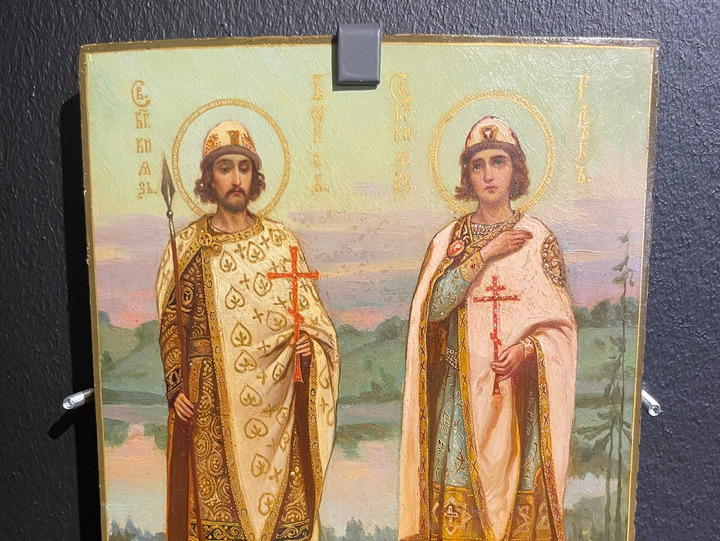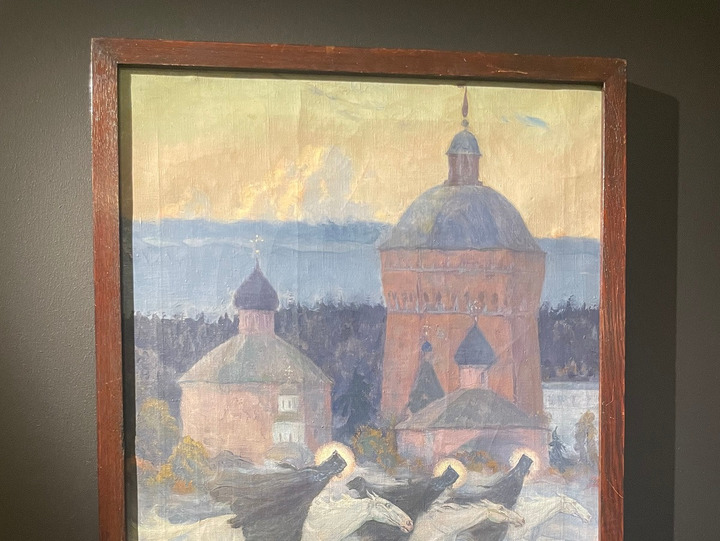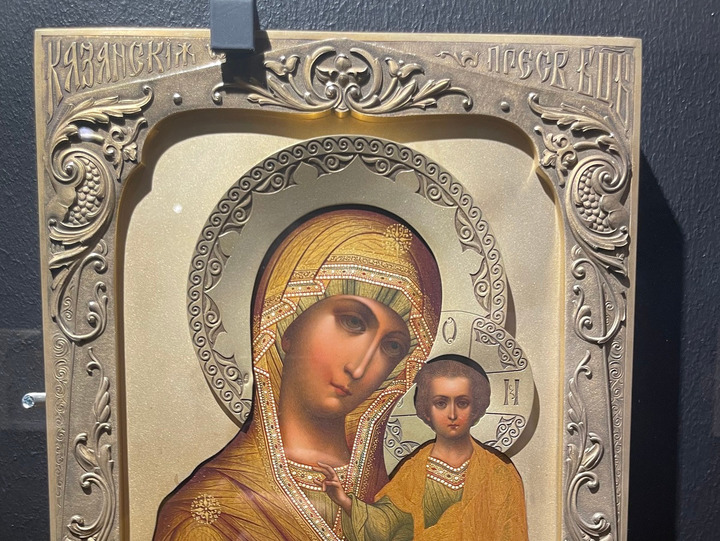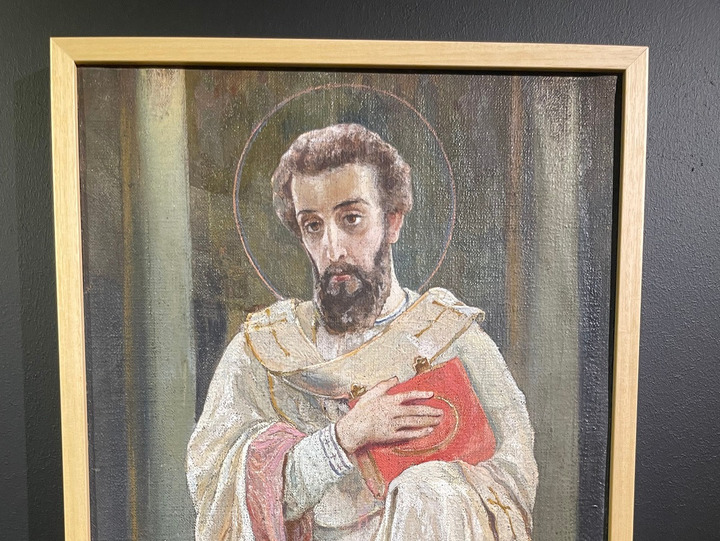Art Nouveau icons shown at the Rublev Museum
[ad_1]
The exhibition opens little-known pages of Russian art
The Rublev Museum presented an exhibition of icons that 40 years ago were not considered valuable from an art history point of view, and now collectors are chasing such works. Art Nouveau in religious art is a striking and not fully understood phenomenon, largely because this elitist style was considered in Soviet times a relic of the bourgeois past. However, the presented project not only shows the religious art of this trend for the first time, but also reveals its connections with subsequent trends in art. One of the curators of the exhibition, director of the Rublev Museum Mikhail Mindlin is sure that its manifestations can be found in constructivism.
The background for this exhibition is two colors – yellow and black, which symbolize the divine light and its absence in iconography. In contrast, Orthodox art and secular art are combined here. Art Nouveau came to icon painting at the turn of the 19th and 20th centuries precisely from secular art. There is some strange and symbolic manifestation of fate in this, because at that time many monuments of icon painting were rediscovered, which had their impact on the revolution in art, seemingly far from religion. It is believed that Rublev’s darkened Trinity, cleared of age-old soot at the beginning of the 20th century, became one of the catalysts for the creation of the Black Square by Kazimir Malevich (it is no coincidence that at the 0.10 exhibition he hung the painting as an icon – in the “red corner”). The same restorers who opened iconic icons at that time also painted their own – in the Art Nouveau style. At the exhibition, you can find the works of Vasily Guryanov, who in 1904 arrived at the Trinity-Sergius Lavra, took the Rublev icon out of the iconostasis, freed it from the salary and late layers, while removing part of the original painting. Something from Rublev’s images is also read in the author’s icons of Guryanov. Here is his “Our Lady of Kazan”, written in 1908-1917: a chiseled nose, large compassionate eyes, thin lips. Almost like in the images of the great predecessor. But the clothes are written differently – this is pure modernity. There are all the characteristic features of the style here – a paradoxical combination of decorative conventionality, ornamentality, figures and faces “sculpted” with sculptural clarity, attention to nuances. However, this is not the most important thing in this style.

– Art Nouveau is characterized by the creation of a psychological effect and an emotional impression, – Zhanna Belik, one of the curators of the exhibition, the head of the examination department of the Rublev Museum, tells MK. – It is not only the image that plays a role, but also the background. Art Nouveau came to icon painting from secular painting. At that time, the artists were faced with the task of creating a national type: the saints were depicted against the backdrop of Russian nature, with a Slavic type of appearance, in the clothes of Russian princes. A person, entering the temple, had to feel belonging and kinship with the depicted images. Many well-known artists at that time received orders for icons: for example, Ilya Repin could paint his large canvases for years, earning money by creating icons.

However, other artists had the greatest influence on the development of icon painting in the Art Nouveau style – these are Mikhail Nesterov and Viktor Vasnetsov. In the center of the exhibition you can find little-known works by Nesterov from his legendary cycle dedicated to Sergius of Radonezh. But in addition to the “Vision to the lad Bartholomew” and several other works familiar to everyone from school, the artist had many other works dedicated to the saint. Nesterov saw in the image of Sergius of Radonezh the basis of Russian culture. And even years after the revolution, when religion was banned, he continued to write Orthodox stories with a national flavor. At the exhibition you can find several of these rare paintings, painted in the 1920s.

“Mikhail Nesterov is one of the founders of Art Nouveau, he worked in this style starting in the 1880s,” says Zhanna Belik. – He continued to work in the same style in the 1930s, under the new government. Here is the work of 1926, where Nesterov places the lad Bartholomew, Jesus Christ and Sergius of Radonezh in Russian rural nature. We can find in the exhibition icons depicting Boris and Gleb in the same style and on a similar background, which indicates the influence of Nesterov’s painting. And here is the painting “Three Horsemen in White”, which illustrates an episode from the life of St. Sergius, when during the siege of the Trinity-Sergius Lavra by Polish interventionists he sends three students for help. This moment is described in detail in the life, even the colors of the horses are indicated – one was black and two brown. But Nesterov writes them in white, as if flying over fog, in order to create the right emotional mood and convey the atmosphere of a miracle. Although it is important for Christian art to accurately follow the text of life.
These techniques are also adopted by icon painters. At the exhibition, you can compare works written by monks and professional artists, and find a lot in common between them. But Art Nouveau is manifested not only in picturesque features, but in the decorative design of icons. Salaries are made by masters of arts and crafts – and are gaining wide recognition all over the world.

“Soviet art criticism treated modern aesthetics with disdain,” another curator of the exhibition, director of the Rublev Museum, Mikhail Mindlin, tells MK. – Modern was considered a decadent bourgeois style. Sometimes it was said that this art is not of the highest taste, which is not fair. But in the post-Soviet era, many researchers turned to this problem, such as Evgenia Kirichenko or Dmitry Sarabyanov, and rediscovered this direction. We present a compelling selection of works in the Art Nouveau style – not only iconography, but arts and crafts and painting. It was difficult to find so many monuments. Modern is a synthetic style that has absorbed the styles of past eras and trends, from realistic art to ancient Egyptian and oriental art. Art Nouveau included historicism, symbolism, neo-gothic, and was largely at the heart of subsequent trends. It manifests itself, for example, in constructivist architecture, also built on asymmetry.
[ad_2]
Source link






